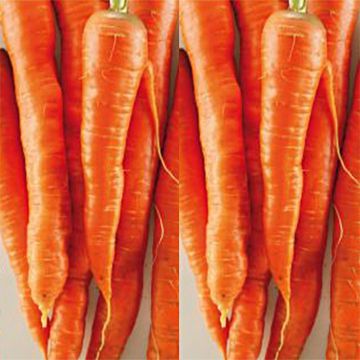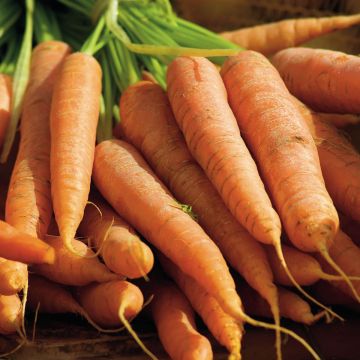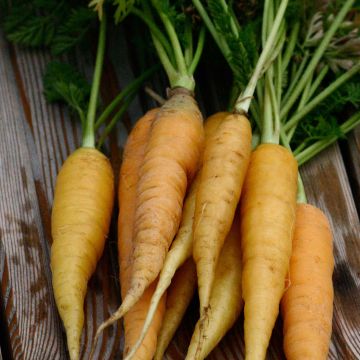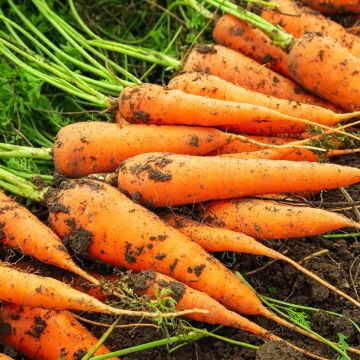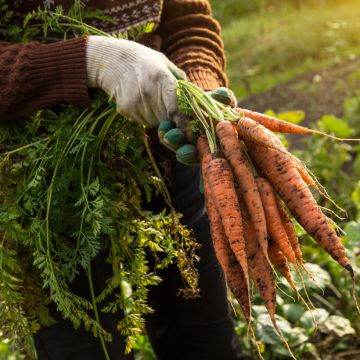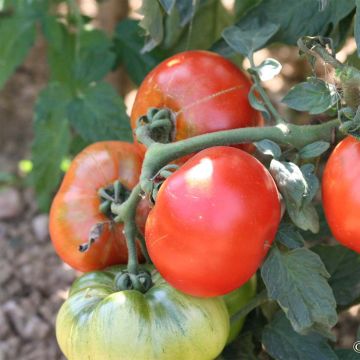

Carrot Adelaide F1 - Daucus carota
Carrot Adelaide F1 - Daucus carota
Daucus carota Adelaide F1
Carrot
Why not try an alternative variety in stock?
View all →This plant carries a 6 months recovery warranty
More information
We guarantee the quality of our plants for a full growing cycle, and will replace at our expense any plant that fails to recover under normal climatic and planting conditions.
Seed-only orders are dispatched by sealed envelope. The delivery charge for seed-only orders is €3.90.

Description
The Adelaide F1 Hybrid carrot is a fast-growing semi-long variety. It will ideally grow in a cold frame, but will also adapt well in your garden. Its skin is smooth and deep orange. The flesh is crunchy and offers a sweet flavour. Spread out the sowings to obtain a regular supply. Sow in January and February under cover, then from March to August in open ground for a harvest from May to October.
The carrot is a biennial herbaceous plant, grown as an annual, from the Apiaceae family. It is grown as a vegetable for its edible, fleshy, and generally orange-colored taproots. It is a root rich in carotene. It can generally reach a height of 30 cm (12in). The carrot is not very demanding on the type of soil. However, the best roots will be harvested in a rich, light, and deep soil. Therefore, it is necessary to prepare the soil by deep digging in autumn, during which 2 to 3 kg of well-decomposed manure or compost will be buried. All stones will be removed during this operation. Before sowing, the soil will be well crumbled and fertilized with a base fertiliser, then left as it is for about fifteen days. Sowing can then take place.
Harvest: during the season, harvest carrots as you need them. To extract the roots from the soil, use a fork-spade, taking care not to damage the root. Injuries to the roots can trigger carrot rot during storage.
Yield estimates can be made based on the type of cultivation and carrot. For early cultivation, plan between 1 and 1.5 kg/m²; about 3 kg/m² for seasonal cultivation of a semi-long variety, and up to 5 kg for late cultivation of long carrots.
Storage: it can be done in the ground, on the cultivation site, but this immobilizes a growing space in the vegetable garden. In winter, in this case, it will be necessary to protect the roots from frost with a good layer of dead leaves. Indoor storage is an excellent long-term solution. In a frost-free and ventilated place, cut the foliage at the base of the collar and place the roots next to each other on a bed of moist sand. Cover them with a 2 cm (1in) layer of sand and place the next row.
Gardener's tips:
Sowing radishes and carrots on the same row and at the same time naturally distances the carrot seeds. Once harvested, the radishes will leave space for the carrots to grow. It's a winning thinning-out technique!
Sowing carrots near a row of leeks helps protect them both from the carrot fly and the leek moth.
Report an error about the product description
Harvest
Plant habit
Foliage
Botanical data
Daucus
carota
Adelaide F1
Apiaceae
Carrot
Cultivar or hybrid
Annual
Other Carrot seeds
Planting and care
Sowing description:
A sowing is done in rows, well ventilated, in a flat furrow about ten cm wide and 2 cm (1in) deep. The rows should be spaced 25 cm (10in) apart. Cover the seeds with the soil that has been moved aside along the furrow, then water. Keep moist until germination, which takes between 10 and 15 days. As soon as the seedlings reach a height of 3 to 4 cm (1 to 2in), thin out the excess plants, leaving only one every 1 to 2 cm (0 to 1in). A second thinning pass one to two weeks later will allow you to keep only the best plants, every 3 to 5 cm (1 to 2in) for shorter crops (Culture N°1 and 2) and 5 to 8 cm (2 to 3in) for longer crops that will produce larger roots (Culture N°3, 4 and 5).
The 5 types of crops:
Culture N°1: forced culture. Sowing is done in January-February, in a heated shelter at 15°C (59°F), for a harvest of young carrots 75 days later.
Culture N°2: early culture. Sowing is done in February-March, in an unheated shelter, for a harvest of tender carrots in June-July.
Culture N°3: seasonal culture. Sowing is done in March-April, in open ground, for a harvest of half-long carrots from July to September.
Culture N°4: late-season culture. Sowing is done in June-July, in open ground, for a harvest of half-long carrots from September to November.
Culture N°5: late culture. Sowing is done in October-November, in unheated shelters, for a harvest of spring carrots in May. During freezing periods, protect the young plants with a thick layer of dead leaves.
Seedlings
Care
Intended location
This item has not been reviewed yet - be the first to leave a review about it.
Vegetable seeds
Haven't found what you were looking for?
Hardiness is the lowest winter temperature a plant can endure without suffering serious damage or even dying. However, hardiness is affected by location (a sheltered area, such as a patio), protection (winter cover) and soil type (hardiness is improved by well-drained soil).

Photo Sharing Terms & Conditions
In order to encourage gardeners to interact and share their experiences, Promesse de fleurs offers various media enabling content to be uploaded onto its Site - in particular via the ‘Photo sharing’ module.
The User agrees to refrain from:
- Posting any content that is illegal, prejudicial, insulting, racist, inciteful to hatred, revisionist, contrary to public decency, that infringes on privacy or on the privacy rights of third parties, in particular the publicity rights of persons and goods, intellectual property rights, or the right to privacy.
- Submitting content on behalf of a third party;
- Impersonate the identity of a third party and/or publish any personal information about a third party;
In general, the User undertakes to refrain from any unethical behaviour.
All Content (in particular text, comments, files, images, photos, videos, creative works, etc.), which may be subject to property or intellectual property rights, image or other private rights, shall remain the property of the User, subject to the limited rights granted by the terms of the licence granted by Promesse de fleurs as stated below. Users are at liberty to publish or not to publish such Content on the Site, notably via the ‘Photo Sharing’ facility, and accept that this Content shall be made public and freely accessible, notably on the Internet.
Users further acknowledge, undertake to have ,and guarantee that they hold all necessary rights and permissions to publish such material on the Site, in particular with regard to the legislation in force pertaining to any privacy, property, intellectual property, image, or contractual rights, or rights of any other nature. By publishing such Content on the Site, Users acknowledge accepting full liability as publishers of the Content within the meaning of the law, and grant Promesse de fleurs, free of charge, an inclusive, worldwide licence for the said Content for the entire duration of its publication, including all reproduction, representation, up/downloading, displaying, performing, transmission, and storage rights.
Users also grant permission for their name to be linked to the Content and accept that this link may not always be made available.
By engaging in posting material, Users consent to their Content becoming automatically accessible on the Internet, in particular on other sites and/or blogs and/or web pages of the Promesse de fleurs site, including in particular social pages and the Promesse de fleurs catalogue.
Users may secure the removal of entrusted content free of charge by issuing a simple request via our contact form.
The flowering period indicated on our website applies to countries and regions located in USDA zone 8 (France, the United Kingdom, Ireland, the Netherlands, etc.)
It will vary according to where you live:
- In zones 9 to 10 (Italy, Spain, Greece, etc.), flowering will occur about 2 to 4 weeks earlier.
- In zones 6 to 7 (Germany, Poland, Slovenia, and lower mountainous regions), flowering will be delayed by 2 to 3 weeks.
- In zone 5 (Central Europe, Scandinavia), blooming will be delayed by 3 to 5 weeks.
In temperate climates, pruning of spring-flowering shrubs (forsythia, spireas, etc.) should be done just after flowering.
Pruning of summer-flowering shrubs (Indian Lilac, Perovskia, etc.) can be done in winter or spring.
In cold regions as well as with frost-sensitive plants, avoid pruning too early when severe frosts may still occur.
The planting period indicated on our website applies to countries and regions located in USDA zone 8 (France, United Kingdom, Ireland, Netherlands).
It will vary according to where you live:
- In Mediterranean zones (Marseille, Madrid, Milan, etc.), autumn and winter are the best planting periods.
- In continental zones (Strasbourg, Munich, Vienna, etc.), delay planting by 2 to 3 weeks in spring and bring it forward by 2 to 4 weeks in autumn.
- In mountainous regions (the Alps, Pyrenees, Carpathians, etc.), it is best to plant in late spring (May-June) or late summer (August-September).
The harvesting period indicated on our website applies to countries and regions in USDA zone 8 (France, England, Ireland, the Netherlands).
In colder areas (Scandinavia, Poland, Austria...) fruit and vegetable harvests are likely to be delayed by 3-4 weeks.
In warmer areas (Italy, Spain, Greece, etc.), harvesting will probably take place earlier, depending on weather conditions.
The sowing periods indicated on our website apply to countries and regions within USDA Zone 8 (France, UK, Ireland, Netherlands).
In colder areas (Scandinavia, Poland, Austria...), delay any outdoor sowing by 3-4 weeks, or sow under glass.
In warmer climes (Italy, Spain, Greece, etc.), bring outdoor sowing forward by a few weeks.

































